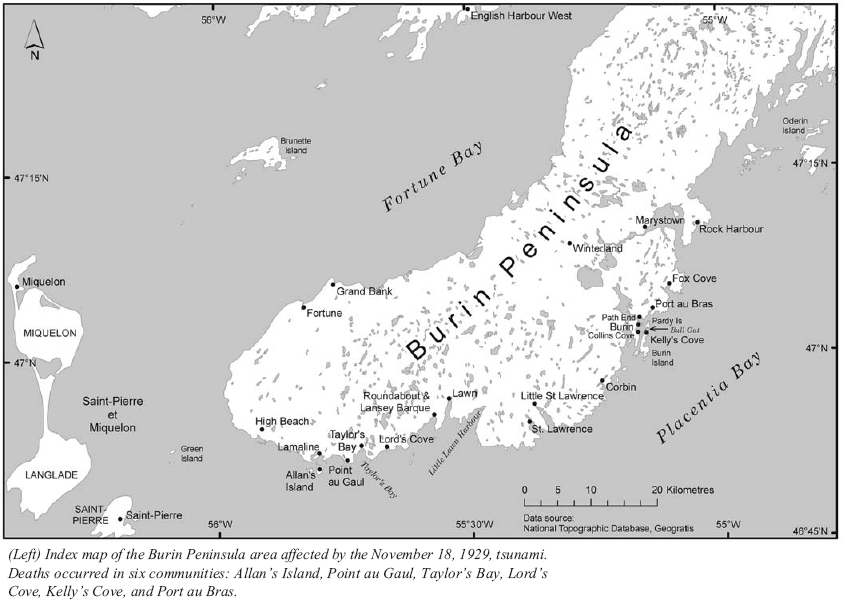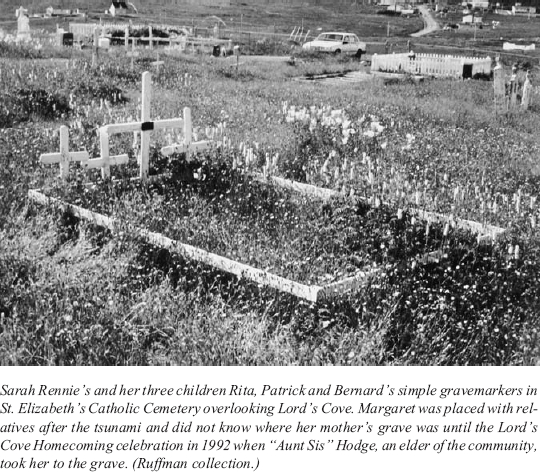The Newfoundland Tsunami of November 18, 1929: An Examination of the Twenty-eight Deaths of the "South Coast Disaster"
Alan RuffmanGeomarine Associates Ltd, P.O. Box 41, Station M, Halifax, Nova Soctia, B3J 2L4 Ph. (902) 477-5415
aruffman@dal.ca
Violet Hann1
Apt. 104 2191 West 39th Avenue, Vancouver, British Columbia, V6M 1T7, Ph. (604) 267-9259
thelookout@shaw.ca
INTRODUCTION
1 THE "GRAND BANKS" EARTHQUAKE occurred at 1702 (Newfoundland Standard Time [NST]) on Monday, November 18, 1929. It was centred eighteen kilometres beneath the Laurentian Continental Slope, 265 kilometres south of Newfoundland's Burin Peninsula, in 2,000 metres of water. The event had a surface wave magnitude of Ms = 7.22 and it was felt as far afield as New York City and Montreal; there is even a serendipitous felt-report in Bermuda.3 Onshore the damage from the earthquake's shaking was restricted to some slumping and minor building damage in Cape Breton Island; Newfoundland, despite its proximity to the epicentre, experienced no physical damage, other than broken crockery shaken off shelves, because most structures were of wood-frame construction built on solid substrates.
2 On the ocean floor offshore, part of the Laurentian Slope was shaken loose and began an underwater landslide that went on for hours, and flowed at least 1,100 kilometres out onto the floor of the 5,000-metre-deep Sohm Abyssal Plain. It was 23 years before scientists recognized the landslide and its great importance as a dominant ocean process.4 The 1929 "turbidity currents" moved at speeds of 50 to 70 knots (93-130 km/s) and cut twelve trans-Atlantic telegraph cables in about 28 places. Repairs involved every available cable ship in the Atlantic and continued until August 1930.5 About 200 cubic kilometres of material was removed over an area of 20,000 square kilometres6 of the continental slope and rise. This material was redistributed over an area of 150,000 square kilometres7 out on the abyssal plain; this is an area one-and-one-half times larger than the island of Newfoundland.
(Left) Index map of Atlantic Canada with the 200, 1000, and 2000 m bathymetric contours shown offshore. The epicentre of the November 18, 1929, earthquake is shown at the mouth of the Laurentian Channel located in about 2000 m of water. The flow from the turbidity currents formed from the underwater landslides shaken loose by the earthquake continued for well over 20 hours and travelled from the epicentre out to 5000 m in the southeast corner of the map and continued the same distance again for a total of 1100 km well out onto the Sohm Abyssal Plain.

Display large image of Figure 1
3 The submarine slump spawned a tsunami (often, but incorrectly, referred to as a "tidal wave") that travelled at about 600 kilometres per hour in the deep ocean water south and eastward from the epicentre; it was seen on tide gauges as far afield as Charleston, South Carolina, the Azores, and the west coast of Portugal; it did minor damage in Bermuda, and was seen on the east coast of Martinique in the eastern Caribbean.8 The tsunami travelled at an average speed of 105 kilometres per hour over the shallower water on the continental shelf north and westward. The full force of the tsunami struck the south coast of Newfoundland at about 1930 to 2000 NST after dark on November 18. Contrary to popular scientific belief the tsunami did not arrive during a storm; it was a dead calm moonlit night. Luckily most persons were still awake and up and about, which facilitated their escape. The first indication of the tsunami was a significant withdrawal of the sea. People reported seeing the ocean floor in places where it had never been seen before. Three main pulses swept in. At the heads of the long narrow bays on the Burin Peninsula, the tsunami arrived as foaming, breaking waves near the top of a rising "spring" tide. Over a period of five to ten minutes sea levels rose three to seven metres above normal, lifting houses off their shores, tearing loose moored vessels, and destroying virtually all shore property, wharves, and fish stores. Twenty-five persons lost their lives that night; three died later. The tsunami refracted counterclockwise around the Avalon Peninsula, and slightly affected northeast Newfoundland in the vicinity of Bonavista and Port Union in the early hours of November 19, six to seven hours after it devastated the south-facing harbours of the Burin Peninsula.9 It arrived in eastern Nova Scotia at about 2000 (Atlantic Standard Time) and did minor damage in the Sydney Harbour area, Canso, River Inhabitants, Louisbourg, and Chedabucto Bay; in Halifax Harbour the tsunami was seen in Duncan's Cove, it flowed over the gates of the dry dock for about five minutes, and it was recorded on the tide gauge.10 The tsunami was not physically observed south of Lunenburg. A winter storm was moving up the eastern seaboard and had moved into Nova Scotia by early evening. Its waves masked the tsunami's effects for much of southwest Nova Scotia and along the New England coast.
A collage of six of Father James Anthony Miller's eleven photographs taken on November 19, which appeared in The New York Times on December 8, 1929. His photos never appeared in any of the local newspapers in that they were not yet equipped to reproduce photographs. Father Miller was the Catholic parish priest at Burin. (Ruffman collection.)
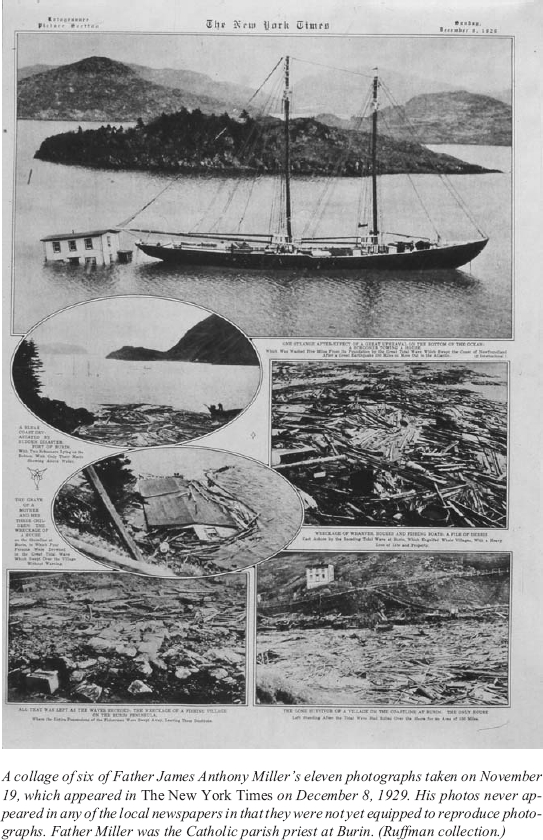
Display large image of Figure 2

Display large image of Figure 3
4 A major storm surge accompanied a winter storm as it arrived in Newfoundland on Tuesday, November 19, just after daybreak.11 This high storm surge, combined with a "spring" high tide at about 0930 NST, has caused some confusion, in that people remember the very high apparent tide as an effect of the "tidal wave" that caused "the South Coast Disaster." In fact, the tsunami was long gone from the vicinity of the island of Newfoundland by 0230-0300 NST on November 19. It is also popularly believed by many older residents that the collapse of the fisheries in the early 1930s and the loss of the eel grass was a direct result of the "tidal wave"; this observation appears to be unfounded.
5 Only four large-magnitude earthquakes are known to have affected the eastern seaboard of North America in historical time. These are the November 18, 1755, event of estimated moment magnitude Mw 6.5-7.0 offshore Cape Ann near Boston, Massachusetts; the August 31, 1886, Charleston, South Carolina, earthquake of estimated Mw 7.0; the November 18, 1929, event of Ms 7.2 in what is now known as the Laurentian Slope Seismic Source Zone; and a November 20, 1933, offshore event of Ms 7.3 in northern Baffin Bay. Thus the probable return rate of a 1929-like event south of Newfoundland is of considerable interest to scientists, and to engneers at the National Research Council of Canada responsible for the National Building Code. The new National Building Code for 2005-2009 has continued to reflect a cautious approach to the Laurentian Slope Seismic Source Zone, and to seismic zones under Passamaquoddy Bay, New Brunswick, and in the Charlevoix region of Québec.12
THE 1929 TSUNAMI DEATH TOLL PROJECT
6 While gathering oral history on scientific questions in 1989, Alan Ruffman realized that the official list of those lost in the tsunami was incomplete, and contained various inaccuracies. Indeed, no accurate official list of the victims has ever been produced by any branch of the Newfoundland government, before or after 1949, and it was this deficiency that the first author set out to correct.
7 It was also clear that in order to fully understand the effect of the tsunami in Taylor's Bay, where it appeared to reach its maximum vertical height, it was necessary to better understand the family connections in what was in 1929 a small, tightly knit community of sixteen or seventeen houses. At this point Violet Hann was introduced to the project through her family in Lamaline, and the process of documenting those lost in the 1929 tsunami has continued intermittently ever since.
8 There have been over 90 contacts with different persons in five provinces of Canada and in three countries. Original records have been checked in seven St. John's archival locations and in about ten southern Newfoundland parishes. Letters of enquiry to newspapers located information in some cases, but not in others. For example, it has proved impossible, in spite of using letters to the local newspapers and the local telephone listings, to obtain information about the Traverse family of Oderin Island; Louisa Allen (née Traverse) remains a lesser known victim.
THE ISOLATION OF THE BURIN PENINSULA
9 In 1929 the Burin Peninsula was still a quarter of a century away from a road connection to St. John's. Indeed, few of the communities along the south coast of the peninsula were linked by more than a cart or walking track. Aroad connected Grand Bank, Marystown, and Burin, more or less along the present route of Highways 213, 222, and 221. The main mode of communication between the coastal villages was by boat, and a single-line local telegraph wire tied the settlements together. Some communities had local phones, but there was no long-distance service. The area was connected to the outside world by local fishing boats, regular coastal ferries, the rare wireless radios on a few of the vessels that might visit, and a single strand of telegraph wire that ran north 150 kilometres over the upland barrens to St. John's.
SS Daisy at the wharf in St John's (Ruffman collection, date and photographer unknown.)

Display large image of Figure 4
10 A storm during the weekend of November 16-17, 1929, had broken this tenuous strand of telegraph wire somewhere north of the settled area on the southern coast of the peninsula.13 When the tsunami arrived, the local telegraph connections between several south coast communities were broken as well. The telegraph station at St. Lawrence ended up floating in the harbour, and that in Lord's Cove was destroyed. Most bridges along the coastal track were floated off or were badly damaged in places like Taylor's Bay, on the Salmonier River between Lamaline and Point au Gaul, and north of Burin on the road to Marystown. None of the vessels in port, such as the revenue cutter SS Daisy at Burin, the coastal ferry SS Argyle which arrived in the area on its regular outward (westward) run from Argentia on the evening of Monday, November 18, and the SS Fernfield which arrived in Burin late on the same day, had operable wireless radios. The SS Daisy had a wireless but, unfortunately, as an unknown writer bemoaned in a letter dated December 6, no one on board knew how to operate it.14 The affected part of the Burin Peninsula was on its own for two and a half days after the tsunami arrived, and small communities were further isolated by the destruction or removal of most, if not all, of their boats.
11 News of damage in places nearer to St. John's arrived more quickly. On the afternoon of November 19, newspapers there reported an apparent earthquake-induced tsunami at Long Harbour in Placentia Bay and damage at Placentia. The Evening Telegram's headline read:15 Yesterday's Earthquake TremorsDisturbances Felt OverWhole IslandTidal wave Causes Considerable Damage atLong Harbour - Shocks Scatter Mercuryat Cape RaceTIDAL WAVE AT LONG HR. A report from Long Hr. Placentia Bay, states that the shocks were felt at six o'clock and again at 10 p.m. Following the disturbance a tidal wave rushed in completely carrying away 76 feet of roadway and causing considerable damage to fishing rooms and stagesSUBMARINE LINES IN PLACENTIAGUT SMASHEDThe Anglo Telegraph Co., had a message this morning from Mr. Verran of Placentia, reporting that all the submarine lines crossing the gut had been smashed.
12 Similarly, The Daily News printed an article headlined "[SS] Nerissa Felt Quake But No Tidal Wave."16
13 There had been no recent experience with earthquakes in Newfoundland17 and none with local tsunamigenic earthquakes. No one suspected the magnitude of the "tidal wave" or its tragic consequences in the south-facing bays and harbours of the Burin Peninsula. In certain harbours, the vagaries of the local coastline geometry that gave a harbour its shelter and safety from storms often served to focus and to constrain the tremendous energy in the tsunami's pulses. In an attempt to lose energy, the tsunami's waves tore up the sea floor, built in amplitude, and often became a breaking wave — then surged forward up onto the land, rising up under the buildings on the shore, flakes, and dwellings, "like a river returning." It was this rise of two to seven metres that took out so much of the shore property and cost the 28 lives.
14 In the cold light of Tuesday morning, November 19, all attention was turned to the location and recovery of bodies, to caring for the injured and homeless, to the salvage of desperately needed supplies, boats, or floating houses, and to dealing with a winter storm that arrived later in the morning of that desperate day. It seems that no one thought of, or had the power to consider, ordering one of the vessels available in Burin, or in several other ports, to proceed directly to Argentia or to the French island of Saint-Pierre, where telegraph or rail connections could have sounded the alarm by noon. Instead, the devastated area struggled on its own through Tuesday, and again all day Wednesday. It was not until the SS Portia, with Captain Wesley B. Kean in charge and with an operating wireless radio on board, arrived in Burin early on the morning of Thursday, November 21, that the following message got out to St. John's via Cape Race:18 EARTHQUAKECALAMTY ONSOUTH COASTMESSAGE TO PRIME MINISTERS.S. "PORTIA" via Cape RacePrime Minister, St John's.Burin experienced very severe earth tremors 5.05 p.m. eighteenth followed at7.35 p.m. by an immense 15 foot tidal wave which swept away everything along water-front. Sixteen dwelling houses with nine lives [lost] mostly women and children. Four bodies recovered. All communications by wire cut off. Report is that 18 lives have been lost at Lord's Cove and Lamaline. S.S. "Daisy" rendering every assistance. St. Lawrence also swept; no lives lost. Destruction property terrible and many people left destitute and homeless. Doing all possible to relieve suffering. "Daisy" now at Lamaline. Writing particulars.MAGISTRATE HOLLETT.
(Left) Index map of the Burin Peninsula area affected by the November 18, 1929, tsunami. Deaths occurred in six communities: Allan's Island, Point au Gaul, Taylor's Bay, Lord's Cove, Kelly's Cove, and Port au Bras.NEWSPAPER REPORTS OF DEATHS:ACHRONOLOGY
(a) When the first messages got out — November 21
15 The first reports in the St. John's newspapers of the afternoon of Thursday, November 21, gave nine lives lost in the Burin area and stated that "18 lives have been lost at Lord's Cove and Lamaline" (above). The Burin telegraph operator, Cox, sent longer dispatches to G.J. Veitch, the Superintendent of Postal Telegraphs, which briefly gave the family names of those lost in the Burin area under the headline "Victims of Disaster": "at Kelly's Cove ... Mrs. Vincent Kelly and her daughter ... At Port au Bras ... Mrs. Thos. Fudge and three children ... Mrs. Capt. Sam. Bennett and her brother Henry Dibbon ... and Mrs. William Allan ... bodies not yet recovered"19 (Table 1a).
16 By the next day, Cox had sent another message to Veitch, which appeared under the headline "26 Persons Swept Away: Burin, 10 p.m., Nov. 21 — furthering my previous report:", which added the death toll from the western end of the disaster area;20 "Thomas Lockyer, of Allans Island ... ; Point au Gaul ... with eight lives, namely, T.J. Hipditch, Thomas Hipditch, H.P. Hipditch, E.H. Hipditch, Thomas Hillier (oil inspector), Irene Hillier, Mrs. Eliza Walsh, Miss M.A. Walsh; Taylor's Bay ... four lives lost, namely, Mrs. Robert Bonnell, Bartholomew Bonnell, and two children; and Lord's Cove ... four lives lost, namely, Mrs. P. Rennie and three children" (Table 1a). Lower in the same article a message from C.C. Pitman and John Foote, both Justices of the Peace, dated November 21 from Lamaline under the headline "Known Dead Total Twenty-Seven and Property Loss is Enormous"; introduced the names "Mrs. Henry Hillier and four grandchildren, ... Mary Ann Walsh, aged spinster, and Elizabeth Walsh, widow" for Point au Gaul, and gave, "At Taylor's Bay, Mrs. Robert Bonnell and her children were drowned; also two children of Bertram Bonnell. A child of George Piercy has since died of injuries" (implying at least six were lost at Taylor's Bay). Pitman and Foote also corrected "Thomas" Lockyer to "James"; "At Allan's Island, James Lockyer, aged 81, was crushed by the sea and died in a few hours" (Table 1a).
(b) When the Burin deputation to St. John's arrived — November 22
17 Late on Thursday night, November 21, the SS Daisy left Burin with a three-person deputation which was to confer with the government in St. John's. It consisted of the Hon. G.A. Bartlett, a noted Burin merchant, Father James Anthony Miller, parish priest of the Burin Roman Catholic parish, and Captain W.H. Hollett. The Daisy arrived at Argentia on Friday morning to meet the 9:30 a.m. train, and the deputation was in St. John's by the early afternoon. That evening the deputation met with the Prime Minister, Sir Richard A. Squires, and the Executive Council.
Tsunami victim Fannie Kelly (sitting) beside her home in Kelly's Cove. She died carrying her daughter Dorothy. Their bodies were never found. (Ruffman collection, date and photographer unknown.)

Display large image of Figure 6
18 The next day the newspapers printed the report of the Inspector of Revenue Service, J.H. Dee, to the Collector of Customs, which he had finished compiling as the Daisy crossed Placentia Bay to Argentia.21 The Daisy, under the command of Captain F. Whelan, had found it impossible to land at Lamaline on the Wednesday and at St. Lawrence early on the Thursday since there were no suitable surviving wharves, a lack of daylight, and insufficient calm weather, "but landed at Point au Gaul [later in the morning of November 21] and got report over the telephone" (Table 1b). The same article contained two messages, which had arrived via the Daisy, from the Burin Stipendiary Magistrate Malcolm Hollett, dated November 20 and 21, and addressed to the Prime Minister. These slightly amplified the information in Dee's report (Table 1b).
(c) When the Meigle returned to Argentia — November 27
19 One of the Members of the House of Assembly (MHAs) on the Meigle relief team produced his own list of the dead prior to the submission of the team's final report. Having completed its six-day relief voyage, the Meigle left Burin early on Wednesday, November 27, so as to put its government relief team on the morning train in Argentia and back in St. John's on the same afternoon. The newspapers the next day carried the latest death toll as a report by the Hon. Dr. Harris Munden Mosdell, Chairman of the Board of Health, to the Hon. Dr. Arthur Barnes, Colonial Secretary (the date was erroneously identified by Mosdell as "On Board Relief Ship Meigle, Placentia Bay, November 25th" — not November 27).22
20 In the section of his report entitled "Loss of Life," Mosdell, the MHA for Burin West, noted: "The loss of life through the tidal wave totals twenty-seven. Twenty-five deaths were due directly to the upheaval. Two other deaths occurred subsequently and were due to shock and exposure." Mrs. Vincent Kelly's daughter was named for the first time; Mosdell named the Hipditch children's father for the first time; and he corrected the Allen's [sic] Island loss to James Lockyer (Table 1c). No further lists of those lost in the 1929 "tidal wave" have been published in a Newfoundland newspaper since those of November 28, 1929.
THE VOYAGE OF THE SS MEIGLE AND THE "OFFICIAL"DEATH TOLL
21 When word of the disaster finally reached St. John's via the wireless message from the SS Portia on the morning of November 21, and even before the three-person deputation arrived, the colonial government began to act quickly and decisively. The Hon. H.B. Clyde Lake et al. later stated in their official report thatThe first advice as to earthquake shock and subsequent tidal wave was received by the Prime Minister, Sir Richard Squires, shortly before noon on Thursday, November 21st, 1929. He immediately telephoned Mr. H.B. Clyde Lake, the Minister of Marine and Fisheries, to hold his Department ready for immediate action and during lunch hour directed the Deputy Minister of Marine and Fisheries, Mr. W[illiam] P[atterson] Rogerson, to get in touch with the Railway Authorities for the commissioning of the S.S. "Meigle" as a relief ship.23
(Left) Hillier family photo in front of the family home in Point au Gaul ~1928. Tsunami victim Elizabeth Hillier, grandmother to the three Hepditch children who were lost, is on the right. Her two sons are behind with her husband Henry in front proudly wearing his Temperance League sash. (Reta Kearley collection.)
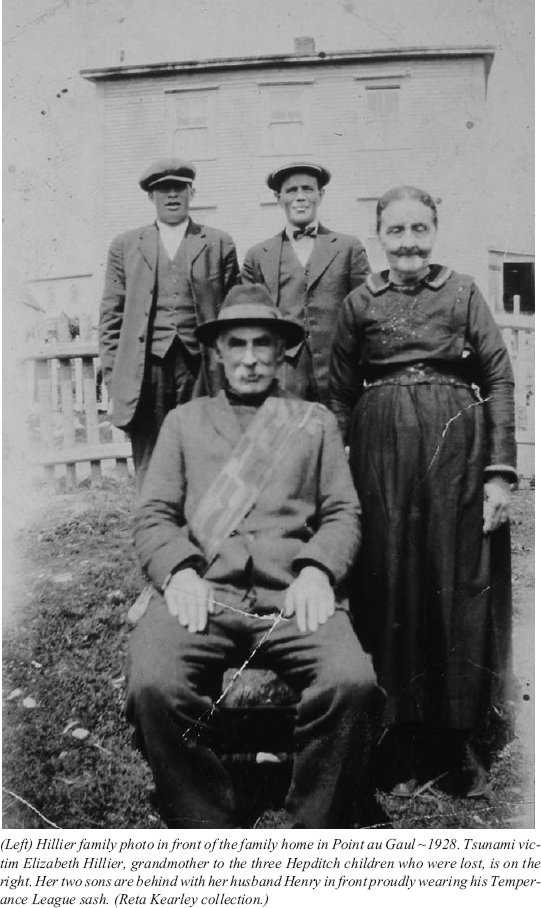
Display large image of Figure 7
22 In a tremendous effort, the SS Meigle, a Newfoundland Railway coastal vessel, and its cargo of government officials, medical personnel, and relief supplies was away from the wharf in St. John's at 9:30 p.m., Thursday, November 21, less than twelve hours after the news of the disaster reached St. John's. The skipper was its regular captain, Albert Burgess, and the complement included the Railway's Marine Superintendent, Captain Martin Gilbert Dalton,24 and five MHAs. Dalton's role was to liaise with the government party, leaving Captain Burgess and his crew free to navigate the vessel.
23 The Meigle arrived in Burin at 3:30 p.m. the next afternoon. Those on board gave medical assistance and distributed relief supplies during a very busy itinerary: Burin (November 22), Point au Gaul (23), Taylor's Bay (23), Lawn (23), Lord's Cove (24), Lamaline (24), Saint-Pierre to purchase supplies (24, evening), Lawn (25, storm), and St. Lawrence (26), returning to Burin on November 26. The relief team also compiled injury and initial loss reports, which were included in its November 28 report to the Prime Minister.25
24 Magistrate Hollett submitted a report for the area between Corbin and Rock Harbour.26 The Daisy had been sent to Lamaline, St. Lawrence, and Point au Gaul on November 20-21, and Inspector Dee had compiled a similar report for the area from Lamaline to St. Lawrence, which he submitted to Hollett on his return.27 Both men noted the lives lost in their respective areas. Table 2 is a compiled transcript of the relevant portions of these two reports.
25 The Meigle left Burin very early on the morning of Wednesday, November 27, to connect with the 9:30 a.m. train at Argentia. The relief team arrived back in St. John's by 1:00 p.m. The official report on the "Voyage of Relief Ship Meigle"28 was submitted to Prime Minister Squires on Thursday, November 28, 1929, just under a week after the vessel first left St. John's. The report contained, among other documents, a "Southwest Coast Disaster Summary," followed by a "List of Lives Lost In Earthquake Disaster."29 This list (full transcript in Table 3) is based on the partial compilations of Hollett and Dee (Table 2) with some minor revisions. "Dibbin" has been corrected to "Dibbon" in Port au Bras, Mrs. P. Rennie's three children are named in Lord's Cove, Mr. Bartholomew [sic] Bonnell has been removed from the list, leaving only his two unnamed children in Taylor's Bay, "T.J. Hipditch" is corrected to "Mrs. Henry Hillier" and "Irence" Hillier is changed to "Irene" in Point au Gaul, and finally "Thomas" Lockyer is corrected to "James" on Allen's [sic] Island.
26 The November 28 list in Table 3 is as close as one can come to an "official" list of those lost in the November 18 tsunami, or what has come to be known as the "South Coast Disaster." It appears that at no time afterwards was the list revised, despite a year-long relief effort. Indeed, the final report (May 13, 1931) of the South Coast Disaster Committee (originally referred to as the South Coast Disaster Fund [or Relief] Committee), chaired by R.F. Horwood, did not even contain a list of those lost.30
DETAILED COMMUNITY LOSSES
(a) Community Loss Tables
27 Tables 4 to 9 record our best efforts to fully identify the 1929 tsunami victims from the communities of Port au Bras, Kelly's Cove (on the north end of Burin Island east of the community of Burin), Lord's Cove, Taylor's Bay, Point au Gaul, and Allan's Island (opposite Lamaline), respectively. The tables list full names, maiden names where relevant, names of spouses and/or parents, date and place of birth and baptism, denomination, age on November 18, 1929, whether the body was recovered, and place and date of burial.
28 These compilations do not change the number of deaths recorded at the time of the tsunami or immediately following the November 18 event. Twenty-seven is still the correct number. In that sense we agree with the Lake et al. list as found in the SS Meigle report of November 28, 1929. However, we have gone well beyond this list, replicated in Table 3, by identifying the unnamed Bonnell child, by defining the full names of most of the victims, especially in the cases of several of the children, by giving married women their own names rather than those of their husbands, by correcting at least eight ages, by providing seven ages where none were originally given, and by correcting the spellings of names.
(b) Addition of a Delayed Death in Taylor's Bay
29 However, we have added one death, that of Amelia Alice Bonnell of Taylor's Bay, who died on March 8, 1933, at age .7.8 years. She had lost her mother Bridget Susannah Bonnell (née Hillier) and her younger sister Mary Gertrude on the night of the tsunami, and we believe that she succumbed to tsunami-related injuries in the spring of 1933.
View from St. Andrew's Anglican Cemetery in Port au Bras in 1989. The stone in the foreground is that of Mary Ann, or "Minie Sam," Bennett whose body was found by a young boy running across floating tsunami debris filling the harbour in the distance. When he slipped and fell he found himself clutching Mrs. Bennett's hair, according to local knowledge. (Ruffman collection.)
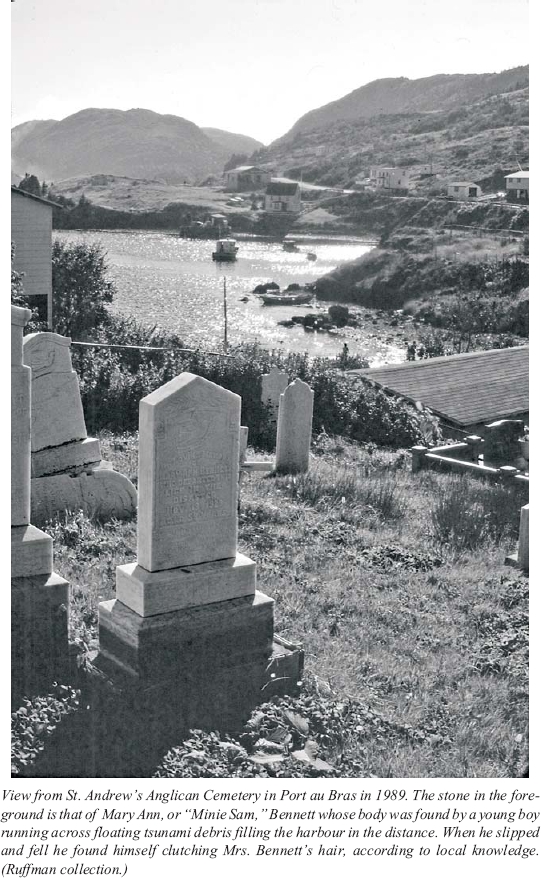
Display large image of Figure 8
30 Amelia Alice's aunt, Mrs. Dinah Ford (née Bonnell) of Waterloo, Ontario, has no doubt that her niece died of the effects of the tsunami. She always had a pain in her head after the tsunami, and apparently was always sickly following the event. Mrs. Ford stated in an interview in 1993 that Amelia Alice died of "sand on the brain," and that sand came down out of her nose on death, presumably draining out of sinuses where it had lodged for over three years. Normally a coroner draws a line at one year after an accident or other traumatic event, and by this measure the young girl, who was £4.5 years old at the time of the tsunami, would not be formally classed as a tsunami death.
31 Few autopsies were performed in rural Newfoundland in the 1920s and 1930s, given a lack of outport doctors, and medical evidence concerning deaths is often lacking. A NONIA nurse31 provided most of the medical care in the Burin area. The second author knows from her own family's experience in Lamaline that in 1929-1933, when it came to medical care or to a coroner's interest in a death, St. John's "was a world away from the bottom of the Burin Peninsula." It would be desirable to have more detailed and proximate medical evidence about this child's death, but we are convinced by the testimony of the child's aunt that Amelia Alice Bonnell did indeed suffer a lingering death caused by the trauma and her injuries resulting from the devastation of Taylor's Bay by the tsunami. Thus we put the 1929 tsunami death toll at 28.
(c) Elimination of a Nova Scotia Death
32 For a number of years the senior author believed that there was a twenty-ninth victim.32 This was John MacLeod, employed in November 1929 as a night security guard in a sawmill owned by R. Dunphy of Point Tupper, Nova Scotia. The sawmill and the guard's shed were on a barge anchored in Lower River Inhabitants in Richmond County, Cape Breton Island. The barge broke loose as the tsunami ran north up the river, and was smashed into the underside of the new railroad bridge some distance upstream. The barge's topsides were crushed and destroyed. The Halifax Herald of Monday, December 16, 1929 (p. 3) reported that MacLeod, a "middle aged man," was missing, and that "interested parties are making inquiries in the vicinity in the hope that something definite will be found out within the next few days." The matter never reappeared in the Nova Scotia newspapers. It was eventually established by the first author that MacLeod was at a local home sharing a meal when the tsunami destroyed his place of work, and he was removed from the list of the 1929 tsunami victims.33
Memory card for Elizabeth Hillier of Point au Gaul. (R. Kearley collection.)BODY RECOVERIES AND BURIALS:COMMUNITY MEMORY
(a) Gravestones and Wooden Markers
33 Six of the tsunami victims'bodies were never recovered: Richard Henry Dibben (of John), age 60.5 and Anna Eliza Dibbon Fudge (Hannah), age 7.2, both of Port au Bras; Frances Elizabeth Kelly (Fannie), age 42.2 and her daughter Dorothy Jane Kelly, age 10.0, of Kelly's Cove; and Mary Gertrude Bonnell, age 1.1 and her cousin John Lewis Bonnell, age 3.1, both of Taylor's Bay, were not recovered and have no onshore marker in a local cemetery. The five recovered Port au Bras victims were buried in the local St. Andrew's Anglican Cemetery, but four of these burials appear to be unmarked, and that of Mary Ann Bennett is mismarked on the gravestone as November "19", 1929 (see photo, p. 113). The burial of Gertrude Fudge, whose body was not found until the next spring, seems not to have been recorded in the St. Andrew's church records. The four Rennie family victims from Lord's Cove have wooden markers in the St. Elizabeth's Catholic Cemetery in Lord's Cove. The four recovered bodies of Taylor's Bay victims are all buried in St. Mary the Virgin Anglican Cemetery in Lamaline, with markers.
34 Two of the eight Point au Gaul victims and James Lockyer of Allan's Island were buried in St. Joseph's Catholic Cemetery on Allan's Island. We have not been able to locate grave markers for the two Point au Gaul victims buried here (Mary Elizabeth Walsh and her sister-in-law Mary Ann Walsh).34 The other six victims from Point au Gaul were buried in St. Mary the Virgin Anglican Cemetery in Lamaline, and most had markers in 1994-1995. However, several of them are only wooden crosses and subject, in the short term, to loss or toppling over.
(b) Post-tsunami Writing and Memory
35 Initially the November 18, 1929, earthquake and tsunami attracted only brief scientific interest. In these early reports the tsunami and its effect in Newfoundland got short shrift and deaths were seldom addressed.35 It was not until the 1952 scientific realization that turbidity currents had been caused, which then progressively ripped up and broke the sea-floor telegraph cables, that the 1929 events received renewed attention. Marine geological research at the Bedford Institute of Oceanography and at Dalhousie University in the 1980-2000 period has concentrated on the turbidity current process and the deposits laid down in the deep ocean — i.e., the offshore signature of the earthquake.36 In the mid-1980s scientific attention turned to locating the onshore signature of the tsunami.37 One of the best examples of a tsunami-laid sand deposit is found at the head of Taylor's Bay.38
36 For the first 60 years after the tsunami, little attention was paid to the social or economic effects of the 1929 tsunami. Little oral history or folklore associated with the onshore effects of the tsunami were collected. Even today the "scientific" aspects of the event draw more research attention than those associated with its effects on the residents and the economy of the area.
Cross marking the graves of the three Hepditch children and their grandmother Elizabeth Hillier as found in February 1995. (Ruffman collection.)
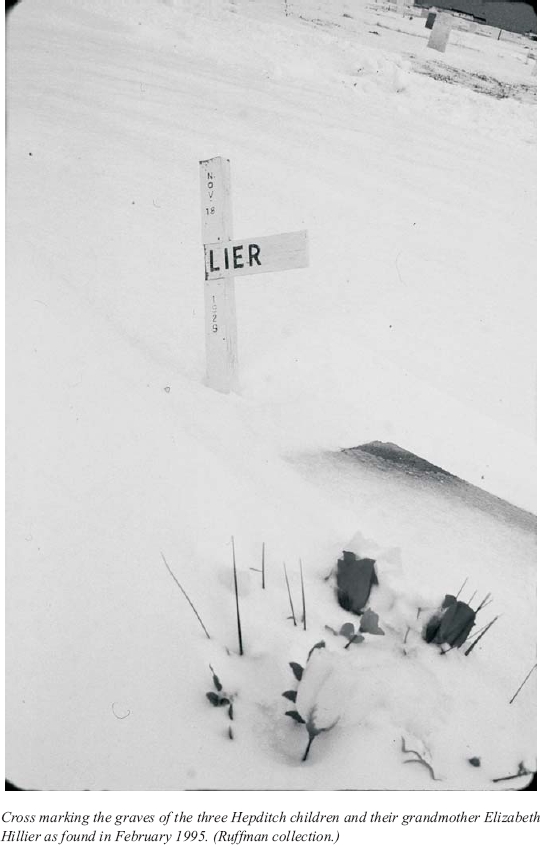
Display large image of Figure 10
37 Margaret Duley, a Newfoundland writer of the mid-twentieth century, wrote a novel based on the event in 1941;39 this contained no attempt to document the deaths from the 1929 event. The only Canadian government report on the "Grand Banks" Earthquake came in 1948 just before the Dominion of Newfoundland confederated with Canada to become the tenth province. W.W. Doxsee gave no list of those lost and did nothing more than report a "summary given in the Saint [sic] John's Free Press in the issue of November 26, 1929."40 Gerald Jones writing on "The South Coast Disaster" in the mid-1970s used the list compiled by the Meigle relief expedition41 as have most other modern writers or journalists.
38 One of the first uses of the oral history of the tsunami on the Burin Peninsula came with the work of the senior author on the Burin Peninsula in a report for Columbia University.42 A major case study of the tsunami in St. Lawrence harbour conducted oral history interviews and contained an early version of our reassessment of the human losses in the tsunami as an appendix.43
39 Writers in the current century, especially with the renewed interest in tsunamis as a natural marine hazard that came with the December 26, 2004, Indian Ocean Tsunami, have continued to use the 1929 Meigle information (as in Table 3). Recent publications have not rectified these errors. Garry Cranford's Tidal Wave, A List of Victims and Survivors — Newfoundland, 1929 in fact has no list of the tsunami victims at all.44 Maura Hanrahan's Tsunami: The Newfoundland Tidal Wave Disaster 45 cites and transcribes some of the documentation, but she too does not list the victims.
40 The Government of Newfoundland and Labrador cannot supply, if requested, an official list of those lost in the 1929 "tidal wave." The memory of those who were lost has faded away in the halls of government. But this is not so in the memories and in the folk and family lore of many Newfoundlanders, especially of the residents of the Burin Peninsula. Our final Table 10 gives what we think is the best list of those lost; Tables 4 to 9 attempt to fit each person into their community. We hope that our seven final tables will serve as at least a printed memorial to each victim of Canada's most tragic known historic earthquake and tsunami, the November 18, 1929, "South Coast Disaster" on the Burin Peninsula of Newfoundland.

Display large image of Figure 11
Table 1. Record of Death Toll As First Reported in the St John's, Newfoundland, Newpapers

Display large image of Table 1
Table 2. Death Toll as reported in Transcripts of Excerpts of the Reports of Malcom Hollett, Stipendiary Magistrate, Burin, and of J.H.Dee, Inspector of Revenue Service, who were on board the ss Daisy sent to Lamaline, November 20 and St . Lawrence, then Point au Gaul, on the morning of November 21
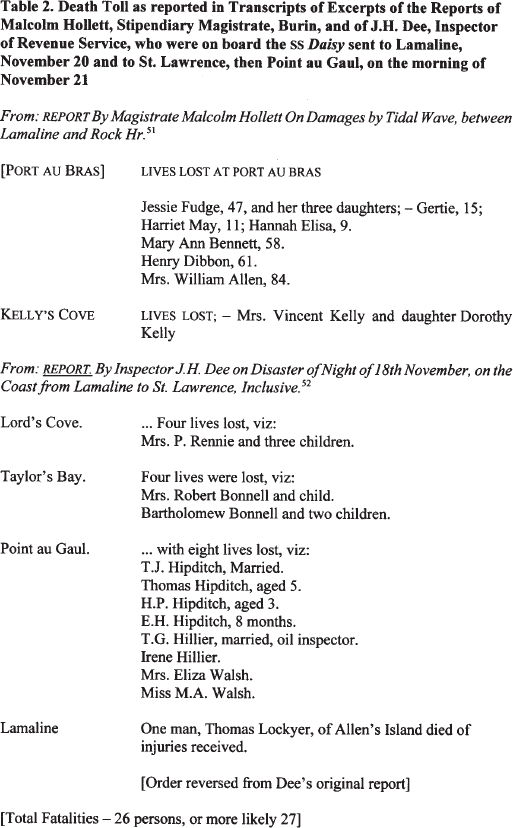
Display large image of Table 2
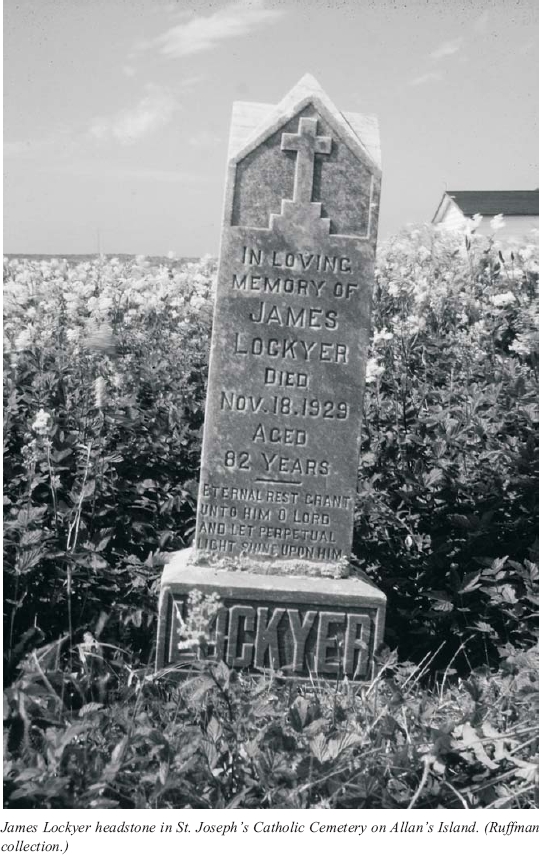
Display large image of Figure 12
Table 3. The Nominal "Official" List of Those Lost: Transcript of the Death List from the Report Prepared on the Voyage of the Relief Ship Meigle
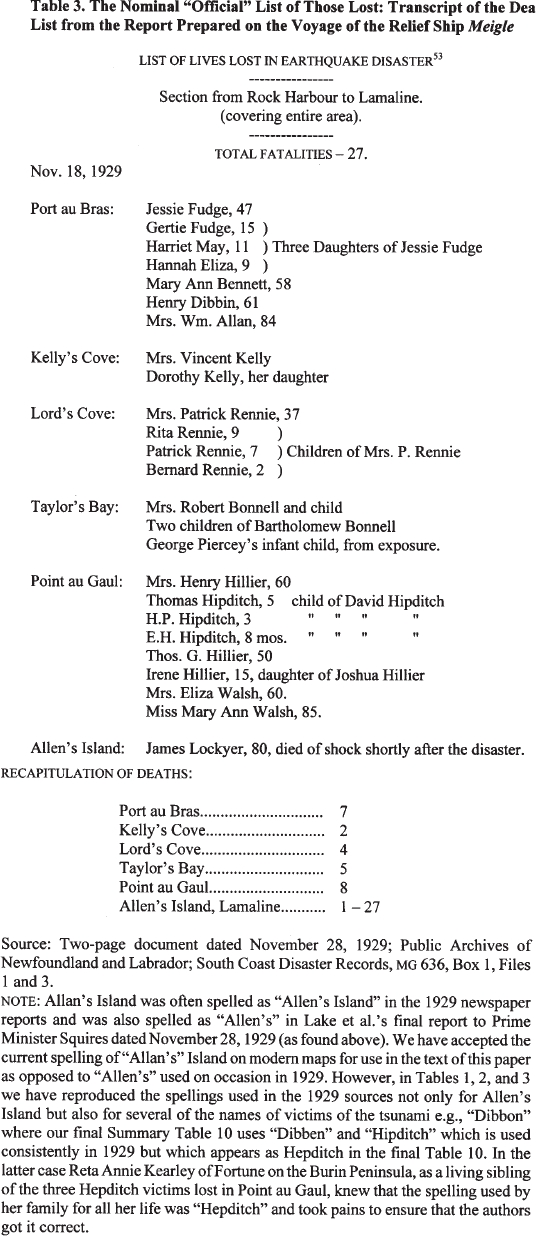
Display large image of Table 3
Table 4. List of the Seven Lives Lost at Port au Bras, November 18, 1929, Tsunami
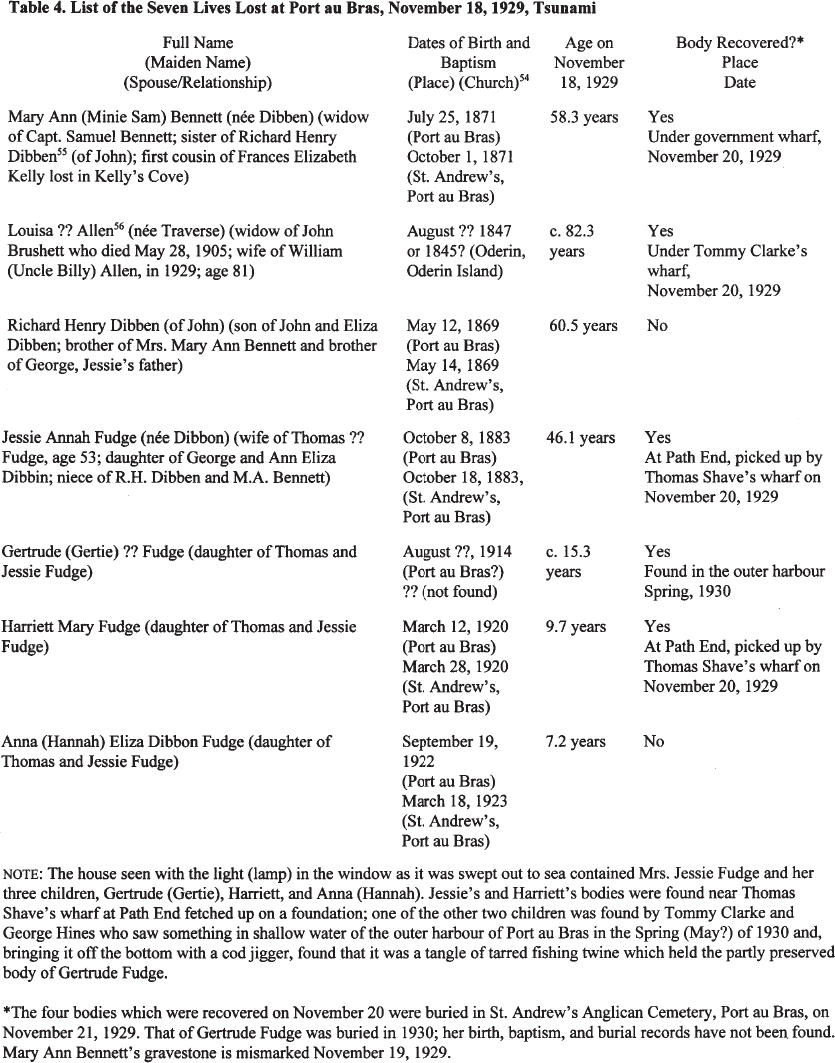
Display large image of Table 4
Table 5. List of the Two Lives at Kelly's Cove on Burin Island, November 18, 1929, Tsunami

Display large image of Table 5
Table 6. List of the Four Lives Lost at Lord's Cove, November 18, 1929, Tsunami
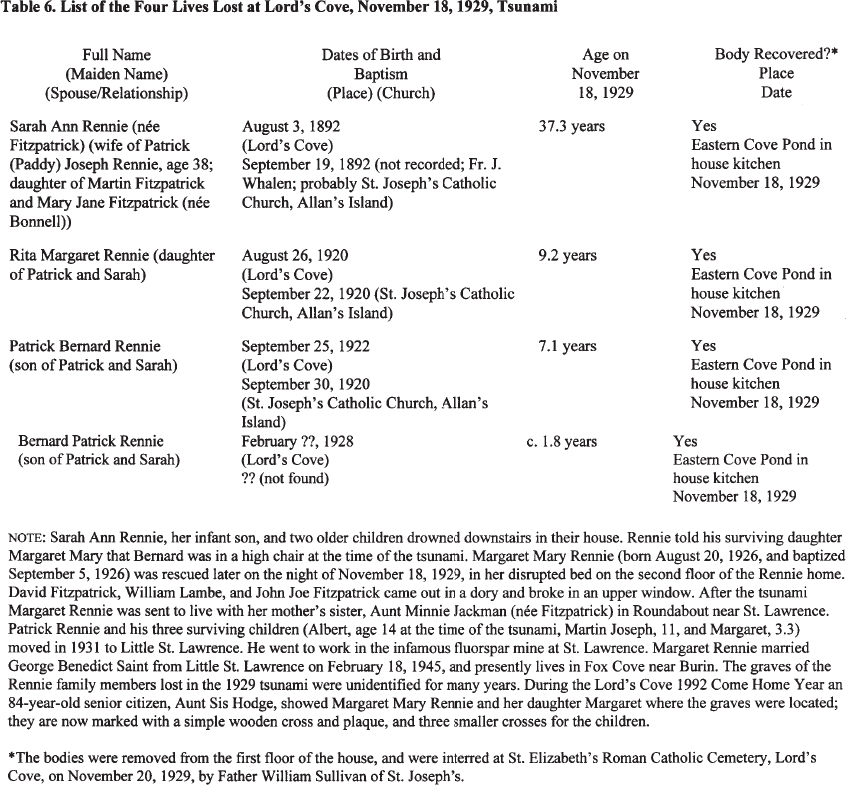
Display large image of Table 6
Table 7. List of the Five (in fact Six) Lives Lost at Taylor's Bay, November 18, 1929, Tsunami

Display large image of Table 7
Table 8. List of the Eight Lives Lost at Point au Gaul, November 18, 1929, Tsunami
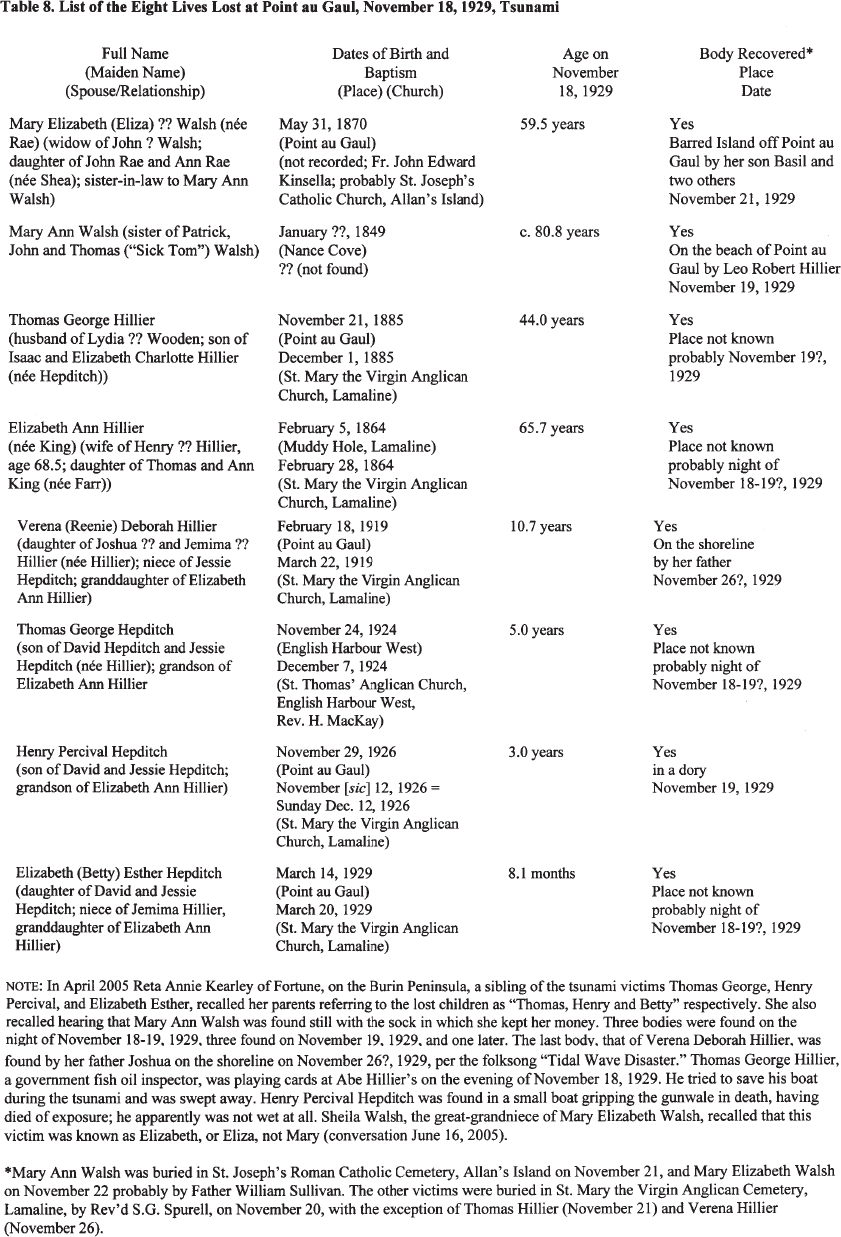
Display large image of Table 8
Table 9. List of the One Life Lost at Allan's Island in the Lamaline Area, November 18, 1929, Tsunami

Display large image of Table 9
Table 10. Final Summary List of Those Lost in the November 18, 1929, Tsunami
Sarah Rennie’s and her three children Rita, Patrick and Bernard’s simple gravemarkers in St. Elizabeth’s Catholic Cemetery overlooking Lord’s Cove. Margaret was placed with relatives after the tsunami and did not know where her mother’s grave was until the Lord’s Cove Homecoming celebration in 1992 when “Aunt Sis” Hodge, an elder of the community, took her to the grave. (Ruffman collection.)Acknowledgements
We would like to recognize the persons below for their individual contribution. If no province, or state, is indicated, the person lives in a community on the island of Newfoundland: Thane Anderson, retired from the Geological Survey of Canada, of Nepean, Ontario; Garfield Bonnell (now deceased) and his wife Gladys of Taylor's Bay; Jennifer Bragg of the Maritime History Archive of Memorial University of Newfoundland, who found Captain Albert Burgess's full name where others had failed; Ron Caplan, Editor of the former Cape Breton's Magazine, Wreck Cove, Nova Scotia, for having spurred the senior author into lifting this manuscript out of a long-ignored file and getting on with it; Gordon Cheeseman of Burin; Clyde Cheeseman (now deceased) and Elizabeth Clarke, both of Port au Bras; Linda Christiansen-Ruffman of Ferguson's Cove, Nova Scotia; Dan Conlin, Curator of Marine History, Maritime Museum of the Atlantic, Halifax, Nova Scotia; Rev. Lochleigh Fiander, Fortune; Agatha Fitzpatrick, Susan and Martin Fitzpatrick, all of Lord's Cove; Rev. Berdina Ford, Rector, Anglican Parish of Burin, Burin; Dinah Ford, Waterloo, Ontario; Evelyn Grondin, formerly of the Burin Heritage House, Burin; Randy Harnett of Clarenville; Brian T. Hill of Mount Pearl, for searching out Violet Hann when the senior author had lost track of her in a long space between drafts; Beatrice Alice Hillier (née Woodland) of Lamaline, mother of author Violet Hann; Launcelot Hillier, now deceased on January 30, 2005, who recalled the spelling of his sister Reenie Hillier's first name; Vanessa Hillier, Lamaline, niece of the second author, who rephotographed grave markers in Lamaline's St. Mary the Virgin Anglican Cemetery in 2005; Wayne Hollett of Burin; Reta A. Kearley of Fortune, a post-tsunami sibling to the Hepditch children lost in Point au Gaul; Noella Walsh King, Lord's Cove; Julia Mathieson, Archivist, Anglican Diocese of Eastern Newfoundland; [A]Dolph McCarthy, Brampton, Ontario; Erik Nielsen, once of Winnipeg, Manitoba; Rev. Jim Pollard, Fortune; Wendy Power, Family History Society of Newfoundland and Labrador, St. John's; Joan Ritcey, Centre for Newfoundland Studies, QE II Library, Memorial University of Newfoundland, who found Captain Dalton's full name; Margaret Mary Saint (née Rennie), Fox Cove; Melanie Tucker, Provincial Archives of Newfoundland and Labrador, The Rooms, St. John's; Martitia P. Tuttle, Georgetown, Maine; Sheila Walsh, Torbay; and LesA. Winsor, Mount Pearl, along with many librarians and archivists, especially in Newfoundland and Labrador. It is these persons who are the community and corporate memory of our society, and it is these and others who we may have inadvertently forgotten over the twelve-year exercise, that we do thank for having given so freely of their time and information. While we have valiantly tried to avoid errors, there certainly are still gaps and there may be some misinterpretations and errors. These are ours entirely. We will be pleased to receive corrections or new data — especially concerning Louisa Allen (née Traverse) of Oderin Island. Finally, Wendy Findley, and before her, Gerry Hickman, laboured over the word processor as various drafts and numerous corrections were generated over about a fifteen-year period. We thank Jennifer Milne of the GIS Centre at Dalhousie University's Killam Memorial Library for help in generating the maps used. We also thank an unnamed reviewer for her/his encouraging comments.The senior author was able to piggyback his oral history research in the field on the Burin Peninsula over seven visits on the shoulders of several scientific projects. These included the Geological Survey of Canada, Geophysics Division in 1986-87, the Canadian Hydrographic Service in 1988-89, the U.S. Nuclear Regulatory Commission along with the Lamont-Doherty Earth Observatory of Columbia University, the University of Maryland's Department of Geology and Dr. Martitia P. Tuttle, M. Tuttle & Associates, Georgetown, Maine from 1993 to 2003, the Geological Survey of Canada, Terrain Sciences Division in 1995, The Royal Canadian Geographical Society in 1994 and 1995, what was then called Emergency Preparedness Canada in 1995-96, Vassar College and Kent State University Departments of Geography and Geology respectively in 2002 and throughout Geomarine Associates Ltd. of Halifax.Note
